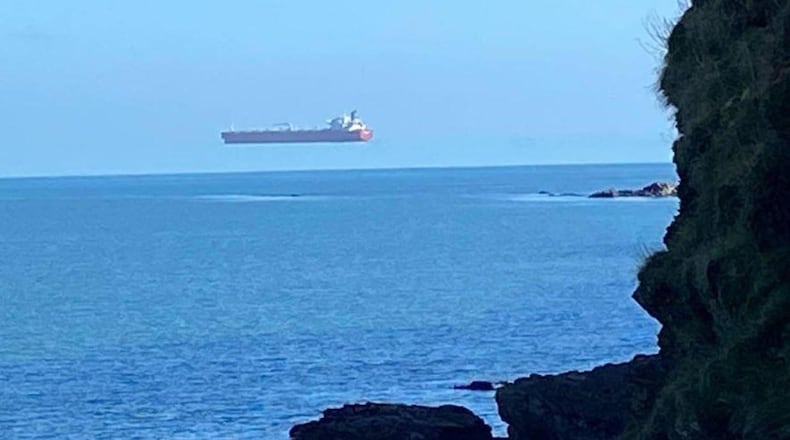Sometimes you just cannot believe your eyes.
A man taking a stroll last month along the cliffs of England’s southwestern coast came upon an astonishing sight as several ships glided along the Celtic Sea.
One of the vessels appeared to hover above the horizon, as if it were floating in midair.
“I told myself, ‘It must be on water,’” said 52-year-old David Morris, a property developer who lives in Cornwall, the most southern point in mainland Britain. “My head doesn’t want to understand that, but it must be on water.”
Morris posted a photo of the strange phenomenon to his Facebook page but didn’t expect it to cause a sensation on social media over the weekend. “It’s just a boat picture,” he said in a telephone interview with The New York Times.
Many were spellbound by the photograph that seemed to depict an impossibility that defied physics and human understanding.
Morris, however, realized the fascinating curiosity was actually just an optical illusion known as a superior mirage, which occurs when the difference in temperature between the ocean and the air causes light from the sun to bend around the horizon.
Cold air typically sits on top of warm air. But on that particular morning last month, the situation was reversed: Cold air lay above the chilly sea, with warm air on top, the Times explained.
The combination of temperature inversion, refracted light and several layers of cold air caused the apparition.
This made the ship appear to be levitating like something out of a science fiction tale.
But it was really only a trick of nature — the ship appeared higher than it should be because the human brain, and apparently cameras, cannot process the effect that different temperatures have on how images are perceived, according to the Times.
Eyes perceive light through straight lines, which only allows for visual discernment that is free from irregularities including curves, bends and angles, said Dr. Claire Cisowski, a research fellow in optics at the University of Glasgow.
“Sometimes an image is deflected when the rays of light that reach us go through different layers,” she said.
A similar phenomenon occurs when we view a straw in a glass of water, which causes the straw to appear broken, because light travels through air and water at different speeds.
The same principle applied with the ship in Cornwall, except that instead of moving from water to air, light traveled from air to air, Cisowski said, according to the Times.
“Air is not always the same — it has different properties whether it’s cold or hot,” she said. “So as light travels differently through these different layers, our brain tries to make sense of that.”
From Morris’ vantage point on the coast, it appeared the ship had taken flight.
“When light reaches our eyes, they can’t retrace the whole trajectory as if it was bent,” Cisowski said. “So we form an image as if it was coming from a straight line, because our eyes want to prolong what they see.”
And like an eye, a camera can’t reconstruct that bent trajectory, either, according to Cisowski. “It’s as if the ray of light was coming from a straight line, too.”
Many voices on social media, however, weren’t buying the scientific explanations and insisted that something more bizarre had occurred.
“Kind of a long winded explanation for aliens got boats now,” one Twitter user remarked.
“Alternative explanation: The ship was actually hovering,” another posted.
“Physics engine error once again proves we’re in the matrix,” someone else said.
Superior mirages are more common in the Arctic, where they occur because temperature differences between the sea and the air cause a similar change in air density with greater frequency, the Times reported.
“I told myself, ‘How lucky we are to live in this part of the world,’” Morris said.
Information provided by The New York Times was used to compile this report.
About the Author
The Latest
Featured



